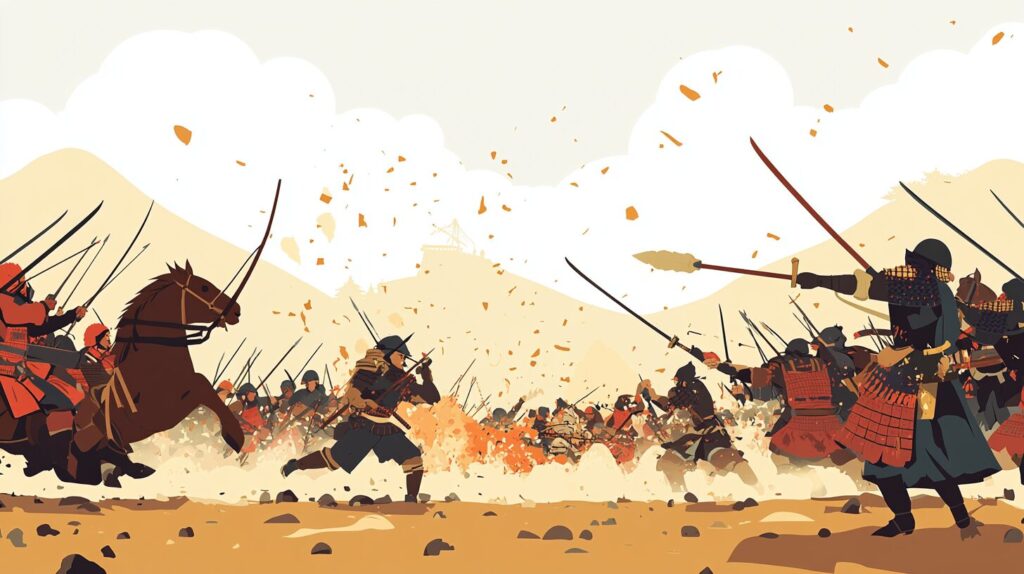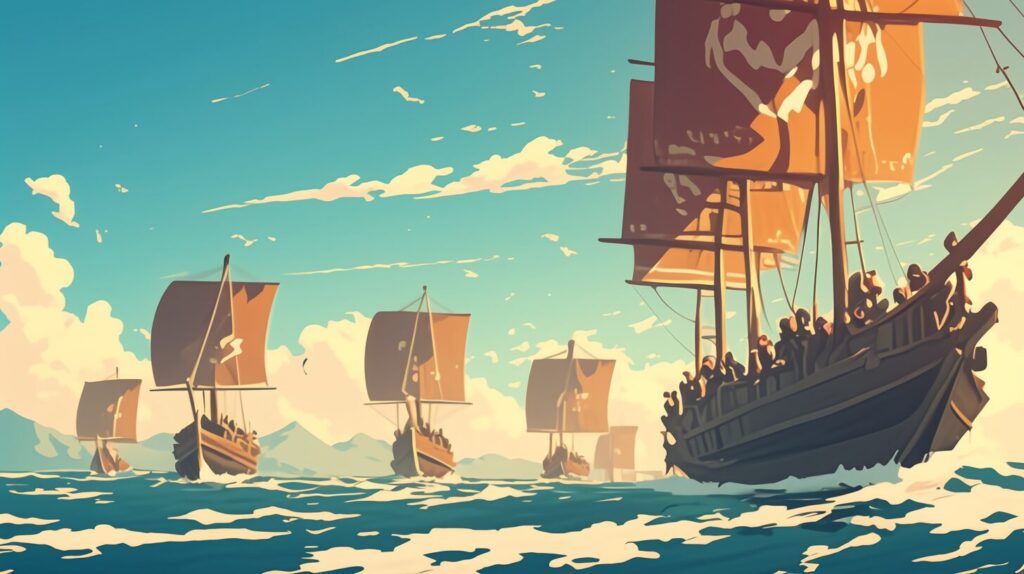元寇(モンゴル襲来)を英語で説明・紹介するための基本情報と、英会話に役立つ表現をシンプルでわかりやすい英語で紹介します。
英会話ダイアローグ・概要・10の質問を通して、元寇に関する英語表現を学びます。
英語
英会話ダイアローグを読む前に知っておくと良い前提知識と情報です。
- 元寇とは(モンゴル襲来の基本)
- 1274年(文永の役)と1281年(弘安の役)の2回のモンゴル帝国(元)による日本侵攻のこと
- モンゴル帝国の皇帝「フビライ・ハン」(元の初代皇帝)が攻めてきた
- 日本をモンゴル帝国の支配下に入れようとしたが、日本が服属を拒否したため
- 日本とモンゴルの戦い方の違い
- モンゴル軍の特徴:
- 組織的な戦術(集団戦、弓騎兵の速攻)
- 火薬兵器を使用(日本は初めて体験)
- 兵士はモンゴル人だけでなく、中国や朝鮮半島の兵も含まれていた
- 日本軍(侍)の特徴:
- 一騎打ちの戦闘スタイル(武士同士が名乗ってから戦う)、剣術や弓矢の個人戦
- 地形を活かした防衛戦(狭い場所で戦いを仕掛ける)
- モンゴル軍の特徴:
- 元寇に関係する重要な出来事と場所
- 神風(かみかぜ):
- 1281年の弘安の役では、巨大な台風がモンゴル軍の船を壊滅させた
- これが「神風(神の風)」と呼ばれ、日本が救われたと信じられた
- 元寇防塁(げんこうぼうるい)(福岡):
- 1274年の戦いの後、日本は次の襲来に備えて博多湾沿いに石の防壁(防塁)を作った
- 円覚寺(鎌倉):
- 1282年、北条時宗(鎌倉幕府の実質的指導者)が戦死者を供養し、国の平和を願って建てた禅寺
- 竹崎季長(たけざき すえなが):
- 元寇で戦った武士で、自分の戦いを記録した絵巻「蒙古襲来絵詞(もうこしゅうらいえことば)」を作らせた
- 現在、東京国立博物館で見ることができる
- 神風(かみかぜ):
2人が元寇(モンゴル襲来)について話しています。
1274年(文永の役)と1281年(弘安の役) のフビライ・ハンによる日本侵攻、防塁の建設、神風による撃退、竹崎季長の絵巻などを話題にしています。
会話 / dialogue

Hey Key, I’ve been reading about the Mongol Invasions of Japan. It’s such an incredible story!

Oh yeah, Genkō, right? It’s one of the most famous events in Japanese history. What got you interested?

I watched a documentary about samurai, and they mentioned how Japan fought off the Mongols twice. I had no idea that happened!

Yeah, it happened in 1274 and 1281. The Mongol ruler, Kublai Khan, wanted Japan to recognize his power. He was also the first emperor of the Yuan Dynasty. When Japan ignored his demands, he sent his army to invade.

That’s crazy! The Mongols were one of the strongest military forces in history. How did Japan manage to stop them?

Well, the samurai fought bravely, but Japan also had some unexpected help—typhoons.

Oh! The famous Kamikaze storms, right? I heard that two massive typhoons destroyed the Mongol fleets.

Exactly. The second invasion in 1281 was massive—over a hundred thousand Mongol soldiers came to attack Japan. But then, a huge storm hit, sinking many of their ships.

So Japan was lucky with the weather?

Partly, but Japan was also well-prepared. After the first invasion, they built a massive stone wall (bōrui) along the coast of Hakata Bay in Fukuoka. It was a defensive wall built to stop the Mongols from landing. That made it much harder for them to invade the second time.

Wow, so they actually improved their defenses between the invasions.

Yeah, and another big difference was the battle tactics. Samurai were used to one-on-one duels, but the Mongols fought in coordinated teams and even used explosive weapons—a type of early gunpowder bomb.

No way! Samurai had never seen that kind of weapon before, right? That must’ve been terrifying!

Exactly. It was a shock, but they adapted quickly and held their ground.

Were there any famous warriors from that time?

Yeah, there was Takezaki Suenaga. He fought in the battles and later hired artists to create an illustrated scroll showing the invasion.

That sounds awesome! Where can I see that scroll?

You can check it out at the Tokyo National Museum. It’s one of the best records of the Mongol Invasions.

I’d love to see that. Are there other places connected to the invasions?

Definitely. In Fukuoka, you can still see parts of the stone wall (bōrui) that helped defend Japan. And in Kamakura, there’s Engaku-ji Temple, which was built by Hōjō Tokimune after the war to honor those who died.

That’s really interesting. It’s amazing how Japan not only survived the invasion but also remembered it in a spiritual way.

Yeah, the Mongol Invasions changed Japan’s military strategies and even influenced later history. It’s a key moment in Japanese history!

I need to visit those places. This is getting more interesting by the minute!

Yeah, you should! I’ll come with you if you want.
概要 / Overview
「元寇(モンゴル襲来)」について、理解を深めるための「英語での概要」です。
元寇(モンゴル襲来)

Introduction
The Mongol Invasions of Japan, also known as Genkō, happened in 1274 and 1281. The Mongol Empire, led by Kublai Khan, wanted Japan to accept its rule. When Japan refused, the Mongols sent a large army to invade. These invasions were some of the most important events in Japanese history.
The First Invasion (1274 – Battle of Bun’ei)
In 1274, Kublai Khan sent around 25,000 soldiers to Japan. The army included Mongols, Chinese, and Korean soldiers. They used powerful bows, explosives (Tetsuhō), and fast cavalry. The Japanese samurai were used to one-on-one duels, but the Mongols fought in organized groups. The Mongols landed on Tsushima, Iki, and Hakata Bay. The Japanese fought hard, but the Mongols had the advantage. However, after a short battle, the Mongol army suddenly retreated, possibly due to supply problems or fear of Japanese reinforcements. A storm destroyed many Mongol ships as they returned home.
The Second Invasion (1281 – Battle of Kōan)
Kublai Khan did not give up. In 1281, he sent a much larger army of over 100,000 soldiers. This time, Japan was better prepared. The Kamakura Shogunate built a large stone wall (Bōrui) along Hakata Bay to stop the Mongols from landing easily. The Japanese held their ground for weeks. Then, a huge typhoon hit the Mongol fleet, destroying thousands of ships. This storm was later called “Kamikaze” (Divine Wind) because it was believed to have saved Japan.
The Impact of the Mongol Invasions
The invasions had a big impact on Japan. The samurai learned new battle strategies, and Japan improved its coastal defenses. However, the war was expensive, and many samurai were unhappy with the government for not giving them enough rewards. This weakened the Kamakura Shogunate, which fell in 1333.
Conclusion
The Mongol Invasions were a major challenge for Japan. Although the Mongols were powerful, Japan’s strong defense and natural disasters helped it survive. These events changed Japan’s military system and became a legendary part of Japanese history.
10の質問 / 10 questions
「元寇(モンゴル襲来)」について、理解を深めるための「英語での10の質問」です。
1: What were the Mongol Invasions of Japan?
The Mongol Invasions of Japan, also called Genkō, were two attacks by the Mongol Empire in 1274 and 1281. Kublai Khan, the ruler of the Yuan Dynasty, tried to conquer Japan, but both invasions failed.
2: Why did Kublai Khan try to invade Japan?
Kublai Khan wanted Japan to become part of his empire. He sent letters demanding Japan’s surrender, but Japan refused. As a result, he sent his army to invade.
3: How many times did the Mongols attack Japan?
The Mongols attacked Japan twice. The first invasion was in 1274, called the Battle of Bun’ei, and the second invasion was in 1281, called the Battle of Kōan.
4: What military tactics did the Mongols use?
The Mongols used organized group attacks, archers on horseback, and gunpowder weapons called Tetsuhō. These tactics were very different from the Japanese samurai’s one-on-one combat style.
5: How did Japan defend itself against the Mongols?
After the first invasion, Japan built stone walls along Hakata Bay to stop the Mongols from landing easily. Samurai also fought bravely to defend their land.
6: What was the role of the typhoons in the Mongol Invasions?
In both invasions, typhoons destroyed many Mongol ships. The storm in 1281 was so powerful that it sank thousands of ships. This event was later called Kamikaze, or “Divine Wind.”
7: What is the significance of the Mongol Invasions in Japanese history?
The invasions showed the strength of the samurai and the importance of Japan’s coastal defense. They also weakened the Kamakura Shogunate because the war was expensive, and samurai were not rewarded well.
8: Who was Takezaki Suenaga?
Takezaki Suenaga was a samurai who fought in the Mongol Invasions. He later created an illustrated scroll, Mōko Shūrai Ekotoba, to record the battles and his bravery.
9: Where can I see historical sites related to the Mongol Invasions?
You can visit the remains of the stone wall in Fukuoka, Engaku-ji Temple in Kamakura, and see the Mōko Shūrai Ekotoba scroll at the Tokyo National Museum.
10: How did the Mongol Invasions affect the Kamakura Shogunate?
The wars were costly, and the shogunate could not reward the samurai properly. This led to unrest among the warriors and contributed to the fall of the Kamakura Shogunate in 1333.

和訳付
会話 / dialogue

Hey Key, I’ve been reading about the Mongol Invasions of Japan. It’s such an incredible story!
キー、日本のモンゴル襲来について読んでたんだけど、すごい話だよね!

Oh yeah, Genkō, right? It’s one of the most famous events in Japanese history. What got you interested?
ああ、元寇のことだね?日本の歴史の中でもすごく有名な出来事のひとつだよ。どうして興味を持ったの?

I watched a documentary about samurai, and they mentioned how Japan fought off the Mongols twice. I had no idea that happened!
侍についてのドキュメンタリーを観たんだけど、日本がモンゴル軍を二度も撃退したって話が出てきたんだ。そんなことがあったなんて知らなかったよ!

Yeah, it happened in 1274 and 1281. The Mongol ruler, Kublai Khan, wanted Japan to recognize his power. He was also the first emperor of the Yuan Dynasty. When Japan ignored his demands, he sent his army to invade.
そう、1274年と1281年に起こったんだ。モンゴルの支配者フビライ・ハンは、日本に自分の権力を認めさせようとしたんだよ。彼は元王朝の初代皇帝でもあったんだ。でも日本はその要求を無視したから、軍を送って侵攻させたんだ。

That’s crazy! The Mongols were one of the strongest military forces in history. How did Japan manage to stop them?
それってすごい話だね!モンゴル軍って、歴史上でも最強クラスの軍隊だったんでしょ?日本はどうやって防いだの?

Well, the samurai fought bravely, but Japan also had some unexpected help—typhoons.
侍たちは勇敢に戦ったけど、日本には思いがけない助けもあったんだ。それが、台風さ。

Oh! The famous Kamikaze storms, right? I heard that two massive typhoons destroyed the Mongol fleets.
ああ、あの有名な神風のことだよね?巨大な台風が二度もモンゴル軍の艦隊を壊滅させたって聞いたよ。

Exactly. The second invasion in 1281 was massive—over a hundred thousand Mongol soldiers came to attack Japan. But then, a huge storm hit, sinking many of their ships.
そうなんだ。特に1281年の二度目の侵攻はすごかったよ。十数万のモンゴル兵が日本に攻めてきたんだ。でも、その時に大嵐が起こって、多くの船が沈んでしまったんだよ。

So Japan was lucky with the weather?
じゃあ、日本は運が良かったってこと?

Partly, but Japan was also well-prepared. After the first invasion, they built a massive stone wall (bōrui) along the coast of Hakata Bay in Fukuoka. It was a defensive wall built to stop the Mongols from landing. That made it much harder for them to invade the second time.
まあ、運もあったけど、日本もちゃんと準備してたんだよ。最初の襲来の後、福岡の博多湾沿いに防塁っていう巨大な石の壁を作ったんだ。それはモンゴル軍が上陸するのを防ぐための防御壁で、二度目の侵攻の時にはモンゴル軍が攻め込むのをかなり難しくしたんだよ。

Wow, so they actually improved their defenses between the invasions.
なるほど、じゃあ日本は一回目の襲来の後、防衛力を強化したんだね。

Yeah, and another big difference was the battle tactics. Samurai were used to one-on-one duels, but the Mongols fought in coordinated teams and even used explosive weapons—a type of early gunpowder bomb.
そう、それに戦い方も大きく違ってたんだ。侍は一騎打ちに慣れていたけど、モンゴル軍はチームで連携して戦ったし、さらに火薬を使った爆発武器まで使ったんだ。

No way! Samurai had never seen that kind of weapon before, right? That must’ve been terrifying!
マジで!?そんな武器、日本の侍は見たことなかったんでしょ?めちゃくちゃ怖かっただろうね!

Exactly. It was a shock, but they adapted quickly and held their ground.
その通り。衝撃的だったと思うけど、侍たちはすぐに対応して、しっかり持ちこたえたんだ。

Were there any famous warriors from that time?
その時代の有名な武士って誰かいる?

Yeah, there was Takezaki Suenaga. He fought in the battles and later hired artists to create an illustrated scroll showing the invasion.
いるよ。竹崎季長っていう武士がいて、元寇で戦った後、自分の戦いを記録するために絵師に依頼して絵巻を作らせたんだ。

That sounds awesome! Where can I see that scroll?
それすごいね!その絵巻ってどこで見れるの?

You can check it out at the Tokyo National Museum. It’s one of the best records of the Mongol Invasions.
東京国立博物館で見れるよ。元寇の記録としては最高レベルの資料だね。

I’d love to see that. Are there other places connected to the invasions?
ぜひ見てみたいな。他にも元寇に関係する場所ってある?

Definitely. In Fukuoka, you can still see parts of the stone wall (bōrui) that helped defend Japan. And in Kamakura, there’s Engaku-ji Temple, which was built by Hōjō Tokimune after the war to honor those who died.
もちろん。福岡には今でも防塁の跡が残ってるし、鎌倉には北条時宗が建てた円覚寺っていうお寺があるよ。戦で亡くなった人々を弔うために作られたんだ。

That’s really interesting. It’s amazing how Japan not only survived the invasion but also remembered it in a spiritual way.
それすごく興味深いな。日本はただ侵略を防いだだけじゃなくて、ちゃんと精神的にもその出来事を記憶してるんだね。

Yeah, the Mongol Invasions changed Japan’s military strategies and even influenced later history. It’s a key moment in Japanese history!
そうだね。元寇は日本の軍事戦略を変えたし、後の歴史にも影響を与えた。日本史の中でも重要な出来事の一つだよ!

I need to visit those places. This is getting more interesting by the minute!
その場所、絶対に行ってみたいよ。どんどん興味が湧いてきた!

Yeah, you should! I’ll come with you if you want.
だよね!もしよかったら一緒に行こうよ。
概要 / Overview
元寇(モンゴル襲来)

Introduction
The Mongol Invasions of Japan, also known as Genkō, happened in 1274 and 1281. The Mongol Empire, led by Kublai Khan, wanted Japan to accept its rule. When Japan refused, the Mongols sent a large army to invade. These invasions were some of the most important events in Japanese history.
導入
日本へのモンゴル襲来(元寇)は、1274年と1281年に起こりました。モンゴル帝国の皇帝フビライ・ハンは、日本に服属を求めました。しかし、日本がそれを拒否したため、モンゴル軍は大軍を送り込んで侵略を試みました。これらの侵攻は、日本の歴史の中でも特に重要な出来事のひとつです。
The First Invasion (1274 – Battle of Bun’ei)
In 1274, Kublai Khan sent around 25,000 soldiers to Japan. The army included Mongols, Chinese, and Korean soldiers. They used powerful bows, explosives (Tetsuhō), and fast cavalry. The Japanese samurai were used to one-on-one duels, but the Mongols fought in organized groups. The Mongols landed on Tsushima, Iki, and Hakata Bay. The Japanese fought hard, but the Mongols had the advantage. However, after a short battle, the Mongol army suddenly retreated, possibly due to supply problems or fear of Japanese reinforcements. A storm destroyed many Mongol ships as they returned home.
第一次侵攻(1274年 – 文永の役)
1274年、フビライ・ハンは約2万5千人の兵士を日本へ送りました。この軍隊には、モンゴル人、中国人、高麗人の兵士が含まれていました。彼らは、強力な弓、火薬兵器(てつはう)、そして機動力の高い騎兵を使用しました。日本の侍は一騎打ちに慣れていましたが、モンゴル軍は組織的な集団戦術を使いました。モンゴル軍は対馬、壱岐、博多湾に上陸し、日本軍と戦いました。日本軍は必死に抵抗しましたが、モンゴル軍が優勢でした。しかし、戦闘が短時間で終わると、モンゴル軍は突然撤退しました。これは、補給不足や日本軍の増援を恐れたためかもしれません。さらに、帰還中に暴風雨が発生し、多くのモンゴルの船が沈没しました。
The Second Invasion (1281 – Battle of Kōan)
Kublai Khan did not give up. In 1281, he sent a much larger army of over 100,000 soldiers. This time, Japan was better prepared. The Kamakura Shogunate built a large stone wall (Bōrui) along Hakata Bay to stop the Mongols from landing easily. The Japanese held their ground for weeks. Then, a huge typhoon hit the Mongol fleet, destroying thousands of ships. This storm was later called “Kamikaze” (Divine Wind) because it was believed to have saved Japan.
第二次侵攻(1281年 – 弘安の役)
フビライ・ハンはあきらめませんでした。1281年、彼は十数万の大軍を送りました。しかし、今回は日本も十分な準備をしていました。鎌倉幕府は博多湾沿いに大きな石塁(ぼうるい)を築き、モンゴル軍の上陸を防ぎました。日本軍は数週間にわたって持ちこたえました。そして、ついに巨大な台風がモンゴル艦隊を襲い、数千隻の船が沈没しました。この嵐は後に「神風(かみかぜ)」と呼ばれ、日本を救った神の風だと信じられるようになりました。
The Impact of the Mongol Invasions
The invasions had a big impact on Japan. The samurai learned new battle strategies, and Japan improved its coastal defenses. However, the war was expensive, and many samurai were unhappy with the government for not giving them enough rewards. This weakened the Kamakura Shogunate, which fell in 1333.
元寇の影響
元寇は日本に大きな影響を与えました。侍たちは新しい戦い方を学び、日本は沿岸防衛を強化しました。しかし、この戦争には多くの費用がかかり、戦った侍たちは幕府から十分な恩賞を受けられず、不満を抱きました。その結果、鎌倉幕府の権力は弱まり、1333年に滅亡しました。
Conclusion
The Mongol Invasions were a major challenge for Japan. Although the Mongols were powerful, Japan’s strong defense and natural disasters helped it survive. These events changed Japan’s military system and became a legendary part of Japanese history.
結論
元寇は日本にとって大きな試練でした。モンゴル軍は強力でしたが、日本の堅固な防御と自然の力が日本を救いました。この出来事は、日本の軍事システムを変え、日本史の中で伝説的な存在となりました。
10の質問 / 10 questions
1: What were the Mongol Invasions of Japan?
モンゴル襲来とは何ですか?
The Mongol Invasions of Japan, also called Genkō, were two attacks by the Mongol Empire in 1274 and 1281. Kublai Khan, the ruler of the Yuan Dynasty, tried to conquer Japan, but both invasions failed.
モンゴル襲来(元寇)は、1274年と1281年にモンゴル帝国が日本を攻撃した出来事です。元の皇帝フビライ・ハンが日本を征服しようとしましたが、2回とも失敗しました。
2: Why did Kublai Khan try to invade Japan?
フビライ・ハンはなぜ日本を侵略しようとしたのですか?
Kublai Khan wanted Japan to become part of his empire. He sent letters demanding Japan’s surrender, but Japan refused. As a result, he sent his army to invade.
フビライ・ハンは日本を自分の帝国の一部にしようとしました。彼は日本に服属を求める国書を送りましたが、日本は拒否しました。その結果、彼は軍を送り侵攻を試みました。
3: How many times did the Mongols attack Japan?
モンゴル軍は何回日本を攻撃しましたか?
The Mongols attacked Japan twice. The first invasion was in 1274, called the Battle of Bun’ei, and the second invasion was in 1281, called the Battle of Kōan.
モンゴル軍は2回日本を攻撃しました。最初の侵攻は1274年の文永の役、2回目の侵攻は1281年の弘安の役と呼ばれています。
4: What military tactics did the Mongols use?
モンゴル軍はどのような戦術を使いましたか?
The Mongols used organized group attacks, archers on horseback, and gunpowder weapons called Tetsuhō. These tactics were very different from the Japanese samurai’s one-on-one combat style.
モンゴル軍は、組織的な集団戦術、騎馬弓兵、そして「てつはう」と呼ばれる火薬兵器を使用しました。これらの戦術は、一騎打ちを重視していた日本の侍の戦い方とは大きく異なっていました。
5: How did Japan defend itself against the Mongols?
日本はどのようにモンゴル軍に対抗しましたか?
After the first invasion, Japan built stone walls along Hakata Bay to stop the Mongols from landing easily. Samurai also fought bravely to defend their land.
最初の侵攻の後、日本は博多湾沿いに防塁を築き、モンゴル軍の上陸を防ぎました。また、侍たちは勇敢に戦い、自国を守りました。
6: What was the role of the typhoons in the Mongol Invasions?
モンゴル襲来で台風はどのような役割を果たしましたか?
In both invasions, typhoons destroyed many Mongol ships. The storm in 1281 was so powerful that it sank thousands of ships. This event was later called Kamikaze, or “Divine Wind.”
2回の侵攻の両方で、台風が多くのモンゴル軍の船を破壊しました。特に1281年の台風は非常に強力で、数千隻の船を沈めました。この出来事は後に「神風」と呼ばれるようになりました。
7: What is the significance of the Mongol Invasions in Japanese history?
モンゴル襲来は日本の歴史においてどのような意味を持ちますか?
The invasions showed the strength of the samurai and the importance of Japan’s coastal defense. They also weakened the Kamakura Shogunate because the war was expensive, and samurai were not rewarded well.
この侵攻は、侍の強さと日本の沿岸防衛の重要性を示しました。しかし、戦争には多大な費用がかかり、戦った侍たちは十分な恩賞を得られず、鎌倉幕府の弱体化につながりました。
8: Who was Takezaki Suenaga?
竹崎季長とは誰ですか?
Takezaki Suenaga was a samurai who fought in the Mongol Invasions. He later created an illustrated scroll, Mōko Shūrai Ekotoba, to record the battles and his bravery.
竹崎季長は、モンゴル襲来で戦った侍の一人です。彼は戦いの記録と自身の勇敢さを示すために、「蒙古襲来絵詞」という絵巻を作らせました。
9: Where can I see historical sites related to the Mongol Invasions?
モンゴル襲来に関連する史跡はどこで見ることができますか?
You can visit the remains of the stone wall in Fukuoka, Engaku-ji Temple in Kamakura, and see the Mōko Shūrai Ekotoba scroll at the Tokyo National Museum.
福岡では防塁の遺構、鎌倉では円覚寺、東京国立博物館では「蒙古襲来絵詞」を見ることができます。
10: How did the Mongol Invasions affect the Kamakura Shogunate?
モンゴル襲来は鎌倉幕府にどのような影響を与えましたか?
The wars were costly, and the shogunate could not reward the samurai properly. This led to unrest among the warriors and contributed to the fall of the Kamakura Shogunate in 1333.
この戦争は莫大な費用がかかり、幕府は侍に十分な恩賞を与えることができませんでした。その結果、武士の不満が高まり、1333年に鎌倉幕府の滅亡につながりました。

words & phrases
英会話ダイアローグと関連情報に出てきた単語・フレーズです(例文は各3つ)。

invasion : 名詞
意味: 侵略、侵攻。 The act of entering a place by force, especially by a military group.
(モンゴル軍が1274年と1281年に日本を攻撃したことを指す)
例文:
- The Mongol invasion of Japan happened in 1274 and 1281.
「モンゴルの日本侵攻は1274年と1281年に起こった。」 - The country strengthened its defenses to prevent an invasion.
「その国は侵攻を防ぐために防御を強化した。」 - The army launched an invasion of the enemy’s territory.
「軍隊は敵の領土に侵攻を開始した。」
massive : 形容詞
意味: 巨大な、大規模な。 Extremely large, heavy, or serious.
(1281年の2回目のモンゴル襲来が十数万の大軍によるものだったことを強調する際に使われる)
例文:
- The Mongols launched a massive attack on Japan in 1281.
「モンゴル軍は1281年に大規模な攻撃を仕掛けた。」 - The typhoon caused massive destruction to the Mongol fleet.
「台風はモンゴル艦隊に壊滅的な被害をもたらした。」 - The castle had massive stone walls to protect against invaders.
「その城は侵略者から守るために巨大な石の壁を持っていた。」
duel : 名詞
意味: 決闘、一騎打ち。 A formal or serious fight between two people, often to settle a dispute.
(日本の侍が一騎打ち(duel)を重視して戦っていたことを示す)
例文:
- The samurai were used to fighting in a duel, while the Mongols fought in groups.
「侍は一騎打ちに慣れていたが、モンゴル軍は集団戦を行った。」 - The two warriors had a duel to defend their honor.
「その二人の戦士は名誉を守るために決闘を行った。」 - In history, many conflicts were settled by a duel.
「歴史上、多くの争いが決闘によって解決された。」
gunpowder : 名詞
意味: 火薬。 A substance used to make explosives and firearms work.
(モンゴル軍が日本に火薬兵器を持ち込んだことを説明する際に使用)
例文:
- The Mongols used gunpowder weapons called Tetsuhō.
「モンゴル軍は『てつはう』と呼ばれる火薬兵器を使用した。」 - Gunpowder changed the way wars were fought in history.
「火薬は戦争の戦い方を大きく変えた。」 - The explosion was caused by gunpowder stored in the ship.
「爆発は船に積まれた火薬によって引き起こされた。」
by the minute : 副詞句
意味: 刻一刻と、どんどん変化して。 Increasing or changing very quickly.
(モンゴル襲来の話にどんどん興味を引かれる様子を表す際に使用)
例文:
- This story is getting more interesting by the minute.
「この話、どんどん面白くなってきた!」 - The battle was becoming more intense by the minute.
「戦いは刻一刻と激しくなっていった。」 - My excitement grew by the minute as I learned about history.
「歴史を学ぶにつれて、どんどん興奮してきた。」

